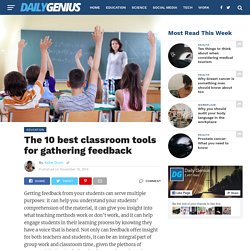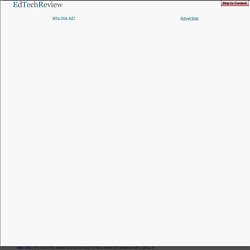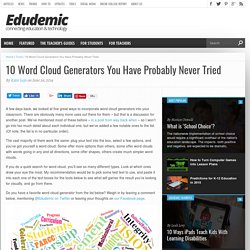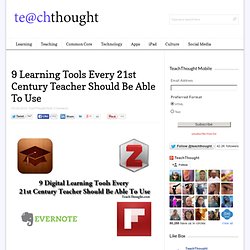

Mind Mapping Software: Mind Maps. The 10 best classroom tools for gathering feedback. Getting feedback from your students can serve multiple purposes: it can help you understand your students’ comprehension of the material, it can give you insight into what teaching methods work or don’t work, and it can help engage students in their learning process by knowing they have a voice that is heard.

Not only can feedback offer insight for both teachers and students, it can be an integral part of group work and classroom time, given the plethora of connected devices in the hands of our students these days. That said, there are a lot of classroom tools available for gathering feedback. You can poll students or have them create a survey for a project, use clickers and other classroom response type tools in real time, get feedback on teaching methods, and more.
But which tools are best? We’ve collected a few of our favorites and listed them below, along with some of the activities they’re best for. Twitter Socrative Verso Plickers Doodle Polldaddy Poll Everywhere. 20 Options for Real-Time Collaboration Tools. About ETR Community EdTechReview (ETR) is a community of and for everyone involved in education technology to connect and collaborate both online and offline to discover, learn, utilize and share about the best ways technology can improve learning, teaching, and leading in the 21st century.

10 Word Cloud Generators You Have Probably Never Tried. A few days back, we looked at five great ways to incorporate word cloud generators into your classroom.

There are obviously many more uses out there for them – but that is a discussion for another post. We’ve mentioned most of these before – in a post from way back when – so I won’t go into too much detail about each individual one, but we’ve added a few notable ones to the list. (Of note, the list is in no particular order). The vast majority of them work the same: plug your text into the box, select a few options, and you’ve got yourself a word cloud. Some offer more options than others, some offer word clouds with words going in any and all directions, some offer shapes, others create much simpler word clouds.
81 Dash - A Nice Backchannel Tool for the Classroom. 81 Dash is a nice backchannel platform that I learned about today during the "Smackdown" at Hack Ed 2014. 81 Dash provides a place for teachers to create chat rooms to use with students to host conversations and share files.

Once you are registered you can begin creating rooms. In your chat room you can exchange messages and files. As the owner of a room you can delete messages written by your students. Students join your 81 Dash room by going to the URL that is assigned to your room. When they arrive at your room for the first time they will be asked to register.
Applications for Education81 Dash resolves the complaint that teachers have about many backchannel tools. Cathy. 9 Digital Learning Tools Every 21st Century Teacher Should Be Able To Use. The 21st century is a time of rapid change, and while the brain may not be changing (much), the tools we use to feed it are.

This puts the 21st century teacher in a critical spot–of mastering constantly evolving technology and digital learning tools–the same tools their students use every day. So below, we’ve started with 9 such tools, but this is obviously just scratching the surface. This list is not meant to be exhaustive (obviously), or even authoritative (but rather, subjective). This is the 21st century, after all. Months after this post is published 2-3 of these tools could be outdated, and if this turns up in the Google search results of a query in 2018, they may seem downright laughable, but here and now, this is a fairly accurate litmus test of what the kinds of tools the average 21st century teacher can be expected to use and master.
And incidentally, it pairs nicely with a related post, 36 Things Every 21st Century Teacher Should Be Able To Do. 1. MixBit. How to use Popcorn Webmaker - Google Slides. Instructions_for_Using_VoiceThread.pdf. Google Forms Cheat Sheet for Teachers. 8 Things You Should Consider Hiding on Your Computer. Your computer knows an awful lot about you, and in a few clicks someone else can, too.

It's more important than ever to keep your digital life as hidden as possible. From password-protected files to folders with misleading names to encryption, there are plenty of methods out there to keep sensitive information tucked away. But besides the obvious sexy photos and porn stash, what other secret stuff should you hide from prying eyes? Below, we've compiled a list of eight things you should consider hiding on your computer. 1. This holiday season, you're probably making a list and checking it twice. 2. Scrub through your computer to see if there are any files that include your online banking information, account numbers and other financial data. If you receive electronic bills and downloaded them to your computer, it's best to take a closer at these documents. 3.
It's best to hide resumes, cover letters and other application forms. 4. 5. Image: Screenshot, Google Chrome 6. 7. 8.